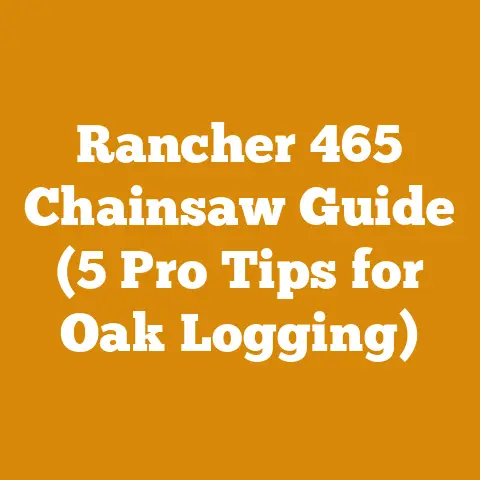Smoking Chainsaw: Common Causes When Cutting Stumps (5 Pro Tips)
Smoking Chainsaw: Common Causes When Cutting Stumps (5 Pro Tips)
Budgeting for chainsaw work, especially when dealing with demanding tasks like stump removal, is a crucial first step. It’s easy to get caught up in the allure of top-of-the-line equipment, but understanding your specific needs and working within a realistic budget will save you money and frustration in the long run. For hobbyists and small-scale loggers, striking the right balance between cost and performance is essential.
When I first started, I made the mistake of buying the cheapest chainsaw I could find. Big mistake! It struggled with even small stumps, overheated constantly, and ultimately cost me more in repairs and replacement parts than a more expensive, reliable model would have. That experience taught me a valuable lesson about prioritizing quality and durability. So, let’s dive into how to approach this budget-friendly.
- Entry-Level Chainsaws: These are typically priced between $150 and $300. They’re suitable for light-duty tasks like pruning small trees and cutting small firewood. However, they often lack the power and durability required for consistent stump removal.
- Mid-Range Chainsaws: Ranging from $300 to $600, these chainsaws offer a good balance of power and reliability. They’re better suited for cutting medium-sized stumps and handling more demanding tasks.
- Professional-Grade Chainsaws: Priced at $600 and up, these chainsaws are built for heavy-duty use and offer the highest levels of performance and durability. They’re ideal for professional loggers and those who regularly tackle large stumps.
Consider rental options. Renting a professional-grade chainsaw for occasional stump removal might be more cost-effective than purchasing one outright, especially if you only need it a few times a year. Rental prices typically range from $50 to $100 per day.
Now, let’s move on to the main topic: a smoking chainsaw while cutting stumps. It’s a problem I’ve encountered more than once, and it’s usually a sign that something isn’t quite right. Ignoring it can lead to serious damage to your chainsaw, or even worse, personal injury.
Understanding the Culprit: Why Your Chainsaw Smokes
A smoking chainsaw is almost always a sign of excessive friction and heat. This friction can be caused by a variety of factors, all of which strain the engine and cutting components. Think of it like running a car with low oil – eventually, something will seize up. Here are the most common culprits:
- Dull Chain: This is the most frequent offender. A dull chain forces you to apply more pressure to cut, which generates excessive friction and heat.
- Insufficient Chain Lubrication: The chain needs a constant supply of oil to reduce friction. If the oiler isn’t working correctly, or the oil reservoir is empty, the chain will overheat quickly.
- Incorrect Chain Tension: Too tight, and the chain binds; too loose, and it vibrates excessively. Both scenarios lead to increased friction.
- Cutting Too Fast: Pushing the chainsaw too hard and fast, especially through dense wood like stumps, overwhelms the chain’s ability to clear chips and generates heat.
- Contaminated or Incorrect Chain Oil: Using the wrong type of oil, or oil that’s contaminated with dirt or debris, reduces its lubricating properties.
- Wood Type and Condition: Cutting extremely dry, hard, or resinous wood can increase friction and heat. Wood that is also dirty or contains embedded rocks or debris will rapidly dull the chain and exacerbate the problem.
Pro Tip 1: Sharpen Your Chain Like a Pro
A sharp chain is the foundation of efficient and safe chainsaw operation. I can’t stress this enough – a dull chain is not only inefficient, but it’s also dangerous. It requires more force, which increases the risk of kickback and other accidents.
Why Sharpening Matters:
- Reduced Friction: A sharp chain slices through wood cleanly, minimizing friction and heat.
- Increased Cutting Speed: A sharp chain cuts faster and more efficiently, reducing the amount of time the chainsaw needs to run.
- Improved Safety: A sharp chain is less likely to kick back, reducing the risk of accidents.
Sharpening Techniques:
There are several methods for sharpening a chainsaw chain, each with its pros and cons:
- Hand Filing: This is the most common and affordable method. It requires a round file, a file guide, and a depth gauge. It allows for precise sharpening, but it takes practice to master.
- File Size: Use the correct file size for your chain’s pitch. Common sizes include 5/32″, 3/16″, and 7/32″. Consult your chainsaw’s manual for the recommended file size.
- Filing Angle: Maintain the correct filing angle, typically around 30 degrees. The file guide helps you maintain this angle consistently.
- Depth Gauge Adjustment: Check and adjust the depth gauges after sharpening. The depth gauges control how much the chain bites into the wood. If they’re too high, the chain won’t cut effectively.
- Electric Chain Sharpener: This method is faster and more consistent than hand filing. It uses a grinding wheel to sharpen the chain. However, it can be more expensive and requires more skill to avoid damaging the chain.
- Wheel Selection: Use the correct grinding wheel for your chain type. Different wheels are designed for different chain pitches and materials.
- Grinding Angle: Set the correct grinding angle according to your chain’s specifications.
- Coolant: Use coolant to prevent the chain from overheating during grinding.
- Professional Sharpening: If you’re not comfortable sharpening your chain yourself, you can take it to a professional. They have the tools and expertise to sharpen your chain quickly and accurately.
My Personal Sharpening Routine:
I prefer to sharpen my chains by hand. I find it more precise and allows me to inspect the chain closely for any damage. Here’s my routine:
- Clean the Chain: Before sharpening, I clean the chain with a wire brush to remove any dirt or debris.
- Secure the Chain: I secure the chain in a vise or use a chain holder to keep it stable.
- File Each Cutter: I file each cutter using a round file and a file guide, maintaining the correct angle and depth.
- Check Depth Gauges: I check and adjust the depth gauges as needed.
- Test the Chain: After sharpening, I test the chain on a piece of wood to ensure it’s cutting properly.
Technical Specifications:
- File Angle: 30 degrees (typical, check your chain manufacturer’s specifications)
- Depth Gauge Setting: Typically 0.025″ to 0.030″ below the cutter top plate (adjust based on wood type and chain type)
- File Size: Determined by chain pitch (e.g., 3/16″ file for 0.325″ pitch chain)
Data Point: A study by Oregon Products found that a properly sharpened chain can increase cutting efficiency by up to 20% compared to a dull chain.
Key Takeaway: Sharpen your chain regularly. It’s the single most important thing you can do to prevent your chainsaw from smoking. I typically sharpen my chain after every 1-2 hours of cutting, or more frequently if I’m cutting dirty or abrasive wood.
Pro Tip 2: Master Chain Lubrication
Proper chain lubrication is crucial for reducing friction and preventing overheating. Without adequate lubrication, the chain and bar will quickly overheat, leading to premature wear and tear, and ultimately, a smoking chainsaw.
Why Lubrication Matters:
- Reduced Friction: Chain oil creates a thin film between the chain and the bar, reducing friction and heat.
- Extended Chain and Bar Life: Proper lubrication prevents excessive wear and tear on the chain and bar, extending their lifespan.
- Improved Cutting Performance: A well-lubricated chain cuts more smoothly and efficiently.
Lubrication System Components:
Understanding the components of your chainsaw’s lubrication system will help you troubleshoot any issues:
- Oil Tank: This is where you store the chain oil.
- Oil Pump: The oil pump draws oil from the tank and delivers it to the bar and chain.
- Oil Outlet: The oil outlet is located on the chainsaw body and delivers oil to the bar.
- Bar Oil Holes: These holes on the bar allow oil to flow to the chain.
Troubleshooting Lubrication Issues:
- Check Oil Level: Ensure the oil tank is full.
- Check Oil Outlet: Make sure the oil outlet is not clogged with debris.
- Check Bar Oil Holes: Clean the bar oil holes with a small wire or toothpick.
- Adjust Oiler Setting: Some chainsaws have an adjustable oiler. Increase the oil flow if needed.
- Inspect Oil Pump: If the oiler is not working, the oil pump may be faulty. Consult a professional for repair.
Choosing the Right Chain Oil:
Selecting the right chain oil is essential for optimal lubrication. Consider the following factors:
- Viscosity: Use a chain oil with the appropriate viscosity for your climate and cutting conditions. Thicker oils are better for hot weather and heavy-duty cutting.
- Tackiness: Choose a chain oil with good tackiness to prevent it from being thrown off the chain.
- Biodegradability: Consider using a biodegradable chain oil to reduce your environmental impact.
- Additives: Some chain oils contain additives that improve their lubricating properties or protect against rust and corrosion.
My Personal Lubrication Practices:
I’m meticulous about chain lubrication. Here’s what I do:
- Use High-Quality Chain Oil: I always use a high-quality chain oil that’s specifically designed for chainsaws. I prefer a biodegradable oil to minimize my environmental impact.
- Check Oil Level Frequently: I check the oil level every time I refuel the chainsaw.
- Clean the Bar Regularly: I clean the bar with a wire brush after each use to remove any dirt or debris.
- Adjust Oiler as Needed: I adjust the oiler setting based on the wood I’m cutting and the weather conditions.
- Inspect the Oiler System: I periodically inspect the oiler system for any leaks or damage.
Technical Specifications:
- Oil Viscosity: SAE 30 or SAE 40 (typical, adjust based on climate and manufacturer’s recommendations)
- Oil Consumption Rate: Varies depending on chainsaw model and cutting conditions. Monitor oil level and adjust oiler setting accordingly.
- Bar Oil Hole Diameter: Typically 0.08″ to 0.12″ (ensure holes are clear for proper oil flow)
Data Point: A study by Stihl found that using the correct chain oil can extend the life of the chain and bar by up to 50%.
Key Takeaway: Don’t skimp on chain oil. It’s a small investment that can save you a lot of money and hassle in the long run. Always use a high-quality chain oil and keep the oiler system in good working order. I’ve seen chainsaws seize up completely due to lack of lubrication – it’s not a pretty sight (or sound!).
Pro Tip 3: Fine-Tune Chain Tension
Proper chain tension is essential for safe and efficient chainsaw operation. Too tight, and the chain will bind and overheat; too loose, and it will vibrate excessively and potentially derail. Finding the sweet spot is crucial.
Why Chain Tension Matters:
- Reduced Friction: Correct chain tension minimizes friction between the chain and the bar.
- Improved Cutting Performance: A properly tensioned chain cuts more smoothly and efficiently.
- Increased Safety: Correct chain tension reduces the risk of chain derailment and kickback.
Checking Chain Tension:
- Warm Up the Chain: Run the chainsaw for a few minutes to warm up the chain.
- Loosen the Bar Nuts: Loosen the bar nuts slightly.
- Adjust the Tensioning Screw: Use the tensioning screw to adjust the chain tension.
- Check the Chain Sag: The chain should sag slightly on the bottom of the bar.
- Tighten the Bar Nuts: Tighten the bar nuts securely.
Adjusting Chain Tension:
- Too Tight: If the chain is too tight, it will be difficult to pull around the bar by hand. Loosen the tensioning screw until the chain sags slightly.
- Too Loose: If the chain is too loose, it will sag excessively on the bottom of the bar. Tighten the tensioning screw until the chain sags slightly.
Maintaining Chain Tension:
- Check Tension Regularly: Check the chain tension regularly, especially when the chain is new. New chains tend to stretch quickly.
- Adjust Tension as Needed: Adjust the chain tension as needed to maintain the correct sag.
- Monitor for Stretching: Watch for signs of excessive chain stretching, such as the need to adjust the tension frequently.
My Personal Chain Tensioning Techniques:
I’m very particular about chain tension. Here’s my approach:
- Warm Up the Chain: I always warm up the chain before checking the tension.
- Use the “Dime Test”: I use the “dime test” to check the tension. I pull the chain down from the middle of the bar. If I can fit a dime between the chain and the bar, the tension is correct.
- Adjust in Small Increments: I adjust the tension in small increments to avoid over-tightening.
- Recheck After Cutting: I recheck the tension after a few cuts to ensure it’s still correct.
Technical Specifications:
- Chain Sag: Approximately 1/8″ to 1/4″ (3-6 mm) sag on the bottom of the bar.
- Tensioning Screw Torque: Refer to your chainsaw’s manual for the recommended torque for the tensioning screw.
- Bar Nut Torque: Refer to your chainsaw’s manual for the recommended torque for the bar nuts.
Data Point: A study by Husqvarna found that maintaining proper chain tension can increase chain life by up to 15%.
Key Takeaway: Chain tension is a balancing act. Too tight, and you’ll burn out your chain and bar; too loose, and you risk derailment and injury. Learn the proper tensioning procedure for your chainsaw and check it frequently. I’ve seen chains snap and go flying due to incorrect tension – it’s a scary experience!
Pro Tip 4: Cut Smart, Not Hard
Cutting technique plays a significant role in preventing your chainsaw from smoking. Pushing the chainsaw too hard or using improper cutting techniques can generate excessive friction and heat. It’s about finesse, not brute force.
Why Cutting Technique Matters:
- Reduced Friction: Proper cutting techniques minimize friction between the chain and the wood.
- Improved Cutting Efficiency: Efficient cutting techniques allow the chain to cut more quickly and smoothly.
- Increased Safety: Correct cutting techniques reduce the risk of kickback and other accidents.
Cutting Techniques for Stumps:
- Plunge Cutting: This technique involves plunging the tip of the bar into the wood to create a hole. It’s useful for cutting thick stumps, but it can be dangerous if not done correctly.
- Avoid Kickback: Be extremely careful to avoid kickback when plunge cutting. Keep the tip of the bar away from any objects that could cause it to catch.
- Maintain Control: Maintain a firm grip on the chainsaw and keep your body balanced.
- Boring Cut: Similar to plunge cutting, but used to create a wider hole.
- Slab Cutting: This technique involves cutting slabs of wood off the stump. It’s a safer and more efficient way to cut large stumps.
- Start at the Top: Start cutting at the top of the stump and work your way down.
- Overlap Cuts: Overlap each cut slightly to ensure a smooth finish.
- Step Cutting: This technique involves cutting a series of steps into the stump. It’s useful for cutting irregularly shaped stumps.
Tips for Cutting Stumps:
- Remove Debris: Before cutting, remove any dirt, rocks, or debris from the stump. These materials can dull the chain quickly.
- Plan Your Cuts: Plan your cuts carefully to avoid getting the bar pinched.
- Use a Sawhorse: Use a sawhorse to support the stump if possible. This will make cutting easier and safer.
- Take Breaks: Take breaks frequently to avoid fatigue. Fatigue can lead to mistakes and accidents.
- Don’t Force the Saw: Let the saw do the work. Don’t force it through the wood.
My Personal Cutting Strategies:
I’ve developed a few strategies over the years that help me cut stumps efficiently and safely:
- Inspect the Stump: I always inspect the stump carefully before cutting to identify any potential hazards.
- Use a Guide: I often use a guide, such as a 2×4, to help me make straight cuts.
- Alternate Cutting Sides: I alternate cutting sides of the stump to prevent the bar from getting pinched.
- Use a Wedges: Use a wedge to prevent the bar from getting pinched.
- Clear Chips Frequently: I clear chips frequently to prevent them from clogging the chain.
Technical Specifications:
- Cutting Speed: Varies depending on wood type and chain sharpness. Avoid forcing the saw; let it cut at its own pace.
- Cutting Angle: Maintain a consistent cutting angle to ensure a smooth finish.
- Chain Speed: Optimal chain speed varies depending on the chainsaw model. Refer to your chainsaw’s manual for the recommended chain speed.
Data Point: A study by the University of Maine found that using proper cutting techniques can reduce cutting time by up to 30%.
Key Takeaway: Cutting technique is just as important as equipment. Learn the proper techniques for cutting stumps and practice them regularly. Don’t be afraid to take your time and plan your cuts carefully. I’ve seen people try to rush through stump removal and end up with damaged chainsaws or, worse, injuries.
Pro Tip 5: Maintain Your Chainsaw Like a Champion
Regular maintenance is essential for keeping your chainsaw running smoothly and preventing it from smoking. Neglecting maintenance can lead to a variety of problems, including overheating, reduced performance, and premature wear and tear.
Why Maintenance Matters:
- Preventative Measures: Regular maintenance can prevent many common chainsaw problems.
- Extended Chainsaw Life: Proper maintenance can extend the life of your chainsaw.
- Improved Performance: A well-maintained chainsaw performs better and more efficiently.
- Increased Safety: Regular maintenance can help identify and correct potential safety hazards.
Essential Maintenance Tasks:
- Clean Air Filter: Clean the air filter regularly to ensure proper airflow to the engine. A dirty air filter can restrict airflow, causing the engine to overheat.
- Cleaning Frequency: Clean the air filter after every 5-10 hours of use, or more frequently in dusty conditions.
- Cleaning Method: Use compressed air or a brush to remove dirt and debris.
- Clean Spark Plug: Clean the spark plug to ensure proper ignition. A fouled spark plug can cause the engine to run poorly.
- Cleaning Frequency: Clean the spark plug after every 25 hours of use.
- Cleaning Method: Use a wire brush to remove carbon deposits.
- Inspect Fuel Filter: Inspect the fuel filter to ensure it’s not clogged. A clogged fuel filter can restrict fuel flow, causing the engine to stall.
- Inspection Frequency: Inspect the fuel filter after every 50 hours of use.
- Replacement: Replace the fuel filter if it’s clogged or damaged.
- Check Chain Brake: Check the chain brake to ensure it’s working properly. The chain brake is a critical safety feature that can prevent serious injuries.
- Testing Frequency: Test the chain brake before each use.
- Functionality: Ensure the chain brake engages quickly and effectively.
- Inspect Bar and Chain: Inspect the bar and chain for any damage or wear. Replace worn or damaged parts as needed.
- Inspection Frequency: Inspect the bar and chain after each use.
- Replace if Damaged: Look for signs of wear, such as cracks, bends, or excessive wear.
- Sharpen Chain Regularly: As mentioned earlier, keep your chain sharp.
- Clean Cooling Fins: Clean the cooling fins on the engine to ensure proper cooling. Overheating can cause serious damage to the engine.
- Cleaning Frequency: Clean the cooling fins after every 25 hours of use.
- Cleaning Method: Use compressed air or a brush to remove dirt and debris.
- Lubricate Sprocket Tip: Lubricate the sprocket tip on the bar to reduce friction and wear.
- Lubrication Frequency: Lubricate the sprocket tip after every 10 hours of use.
- Lubrication Method: Use a grease gun to inject grease into the lubrication hole.
My Personal Maintenance Schedule:
I’m a stickler for maintenance. Here’s my schedule:
- Daily: I clean the bar and chain, check the chain tension, and sharpen the chain as needed.
- Weekly: I clean the air filter, spark plug, and cooling fins. I also inspect the fuel filter and chain brake.
- Monthly: I lubricate the sprocket tip and check the overall condition of the chainsaw.
- Annually: I take the chainsaw to a professional for a tune-up.
Technical Specifications:
- Air Filter Cleaning Frequency: Every 5-10 hours of use
- Spark Plug Cleaning Frequency: Every 25 hours of use
- Fuel Filter Inspection Frequency: Every 50 hours of use
- Sprocket Tip Lubrication Frequency: Every 10 hours of use
Data Point: A study by Oregon Products found that regular chainsaw maintenance can extend the life of the chainsaw by up to 30%.
Key Takeaway: Don’t neglect chainsaw maintenance. It’s an investment in the longevity and performance of your equipment. Follow a regular maintenance schedule and address any problems promptly. I’ve seen chainsaws that were practically new ruined by neglect – it’s a waste of money and resources.






